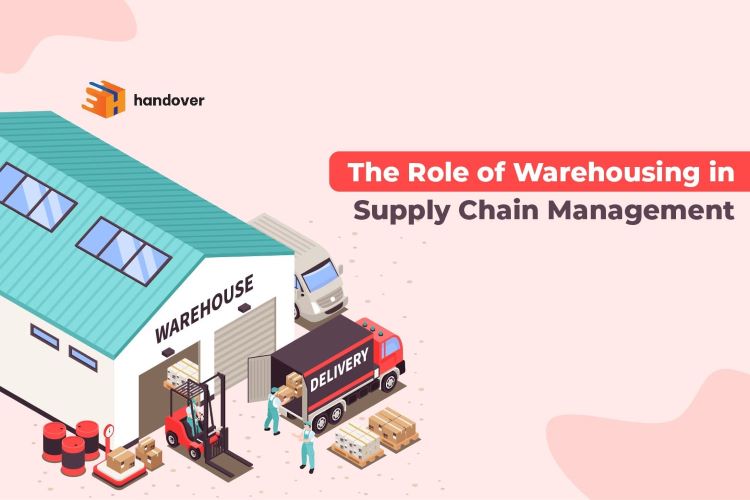Handover news
Blog
Explaining the Role of Warehousing in Supply Chain Management

Warehouses form a critical link in the supply chain, allowing smooth goods storage, aggregation and distribution. They ensure adequate inventory storage and offer services such as labelling, packaging and order fulfilment by helping businesses succeed in a competitive environment. The efficient functioning of warehouses leads to optimal delivery services in Mumbai, Delhi, Ghaziabad, Noida, Kanpur, Lucknow, Bangalore and other cities across India.
The Growth of the Indian Warehousing Industry
The Indian warehousing industry is registering exponential growth owing to factors such as rapid urbanisation, e-commerce expansion, organised retail expansion, increased domestic and international trade, and the introduction of Goods and Services Tax (GST). It is estimated to attain a market size worth US$20 billion by 2025.
Warehousing Technologies Make Supply Chain Robust
The rise of integrated warehousing solutions networks is one of the major market trends marked by the need for improved efficiency and customer services. With companies looking to optimise their supply chain operations, warehouse enterprises continue to invest in advanced technologies such as automation, robotics and Warehouse Management System (WMS) to unleash enhanced productivity and competitiveness.
Warehouse operations are witnessing a wave of transformation owing to these technologies that improve accuracy, speed and efficiency. Businesses continue to invest in technologies such as automated conveyors and robotic pickers to streamline warehouse operations and curtail labour costs. Using data analytics and AI algorithms allows warehouse enterprises to forecast demand and optimise inventory precisely. .
The Rise of e-Commerce and Omnichannel Retailing
It is one of the major trends driving the growth of warehouse enterprises across India. With online shopping hitting new peaks, businesses are enhancing their warehousing capabilities to fulfil the demands of same and next-day delivery services. Additionally, with the fusion of online and offline channels through omnichannel retailing, warehouses must simultaneously handle both e-commerce and traditional retail order fulfilment.
Effective Storage and Inventory Management
Businesses locate their warehouses strategically for inventory storage and maintaining optimal stock levels. Optimal storage helps businesses avoid situations like stockouts and fulfil the demand for products. It further helps warehouses stay strong amid demand and supply fluctuations, facilitating a smooth goods movement even during supply chain disruptions.
Secure Storage Prevents Risk
Warehouses come integrated with advanced security mechanisms, which help businesses prevent their goods from theft, damage and adverse weather conditions. In addition, having several warehouses in various geographical locations can lessen the impact of unforeseen disruptions such as transportation breakdowns or natural disasters.
Warehouses Serve as Consolidation Links
Warehouses accept goods from various suppliers and production centres. Professionals working here merge goods into larger quantities, which help optimise transportation costs and lessens the number of required shipments. Warehouses also facilitate break-bulk operations dividing large shipments into smaller orders for customers. The flexibility ensured by these operations allow businesses to access a wider market and meet customer preferences more effectively.
Value-added Services
Warehouses provide an extensive array of value-added services such as product packaging, labelling and customisation. Packaging helps protect goods during transportation. Additionally, warehouses can execute labelling and customisation tasks as per specific individual requirements, improving customer satisfaction and fulfilling unique needs.
Order Fulfilment
Order fulfilment, which comes at the last stage, depends greatly on how warehouses perform. Warehouses enable the picking, packing and shipping of products. The efficient inventory and order management systems help warehouses minimise order processing time and facilitate precise and fast delivery to end customers. It is therefore crucial for increased customer satisfaction.
Cross Docking
It’s a process where goods arriving at the warehouse from suppliers are unloaded from the vehicle and loaded directly onto another vehicle, virtually requiring no storage. It thus helps reduce warehousing costs and enhance speed to market. This technique proves useful for fast-moving consumer goods.
Conclusion
Warehouses play a pivotal role in India’s economic growth by allowing smooth goods movement from one destination to another. The adoption of advanced technologies ensuring smooth goods storage and despatch further enhances the operational efficiency of warehouses across India.
However, as a business enterprise, if you need effective logistics services, which form a critical segment of supply chain management, collaborate with handover (handover Karo, Khush Raho). It’s a leading logistics company with an extended delivery fleet comprising two-wheelers, three-wheelers, trucks and electric vehicles. Shake hands for a glorious future.
